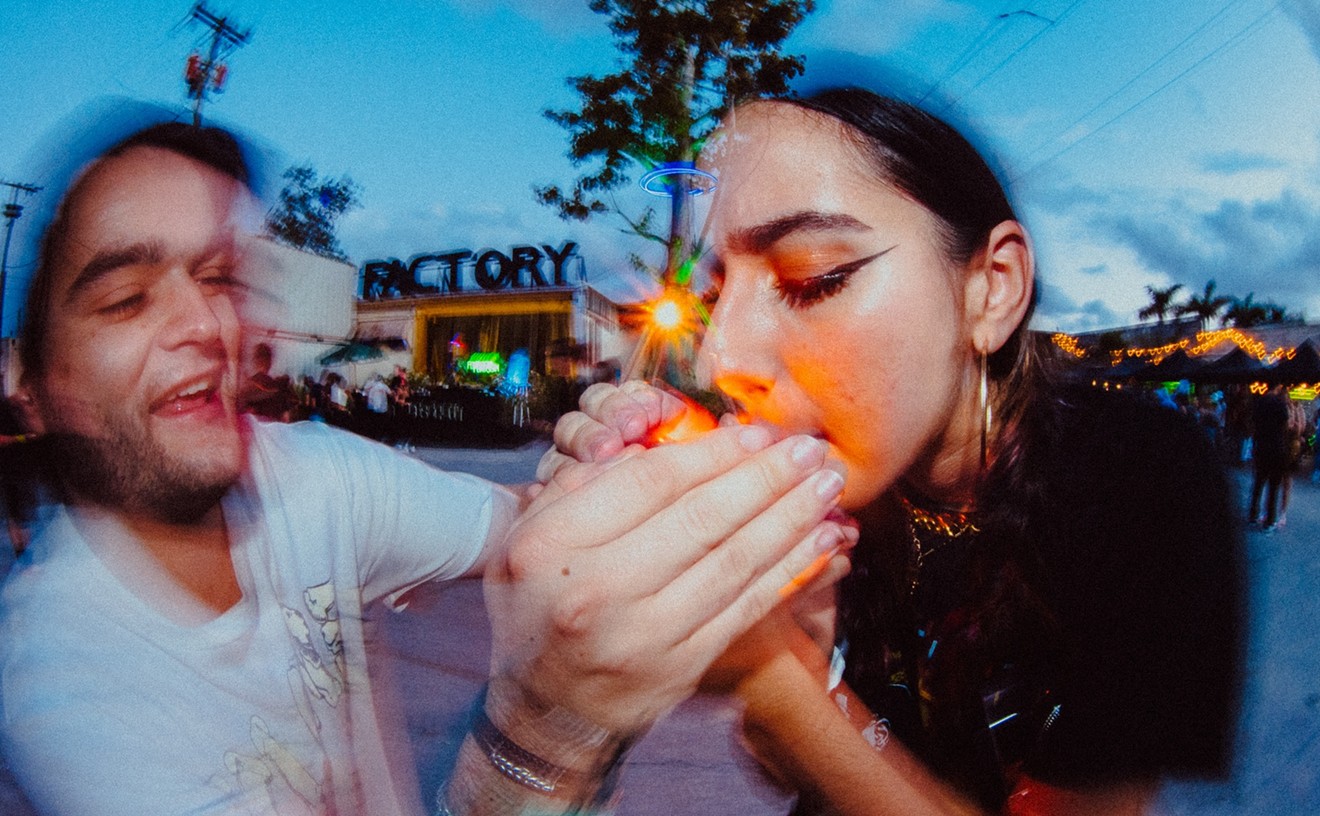"The music of the Rio Magdalena is like the blues along the Mississippi," cries Vives, leaping from a lawn chair on a Mandarin Oriental hotel balcony and gesturing toward the shimmering water below. In the November twilight above Biscayne Bay, Vives could as easily be looking across the Mississippi from St. Louis, New Orleans, or Memphis. The same stars could be reflected in the mighty Magdalena, the river that snakes along the Atlantic Coast from his native Santa Marta, Colombia, to the carnival city of Barranquilla, and then into the interior of the nation where the rural music known as vallenato and cumbia was born. "Carnival in New Orleans is like Carnival in Barranquilla," he exclaims.
Tracing the tributaries of conquest and slavery that fed both the blues and Colombian folklore, Vives repeats the lessons he learned as a teenager at school in Bogotá. "Andean, African, and European all contributed to vallenato, to cumbia," he recites. "There are Indian, African, and European elements to the blues as well." Like Elvis, the Beatles, and Mick Jagger before him, Vives channels these mighty rivers into music all his own, from the groundbreaking Clasicas de la Provincia (1993) to his latest and most innovative disc, Dejame Entrar (Let Me In). "No, there's no doubt;" he insists, "this record is my rock."
For Colombia, a country ripped apart by civil war, vallenato is a fantasy of national harmony. Each of the three races, the story goes, supplied one of the three instruments played in traditional vallenato: The Indian brought the guacharaca (a wooden instrument that is scraped), the African brought the caja (a "box" or drum), and the European brought the accordion. "It wasn't exclusive," says Vives of vallenato's racial mix. "It was mestizo."
As with the blues, legends of the early days of vallenato abound. Old bluesmen and women drifted from town to town; the first vallenatos traveled the countryside on horse or donkey, playing the accordion and improvising lyrics to spread the latest news or serenade local beauties. So powerful was the music that the Devil himself got into the act. Bluesman Robert Johnson is said to have sold his soul at a crossroads in exchange for supernatural skill on the guitar; Francisco "El Hombre" Moscote dueled with the Devil, beating the prince of darkness by playing the Lord's Prayer backward.
But if Francisco the Man beat the Devil, his accordion playing died with him. Only in the Fifties, the Golden Age of Vallenato, did a nascent recording industry begin to spread the popularity of this regional music. The homespun poetry extolling the beauty of land and love appealed to a nation racked by a civil struggle known simply as La Violencia. By the Sixties, however, the lyricism and complexity of the music went into decline. Commercialized by large orchestras, vallenato appealed not so much to poor country folk as to the lowest common denominator. When the drug economy took hold in the Seventies and Eighties, the narcs took a fancy to the form, adding cash flow and a new hint of disrepute to the genre.
Then Carlos Vives came along.
Vives came to vallenato in a career that is almost Elvis in reverse. Where Presley followed his string of Fifties rockabilly hits with a series of schlock films designed to sell dreadful soundtracks and showcase his pretty pout, Vives started out as a galan, or heartthrob, on a series of Colombian and Puerto Rican telenovelas -- often supplying a schmaltzy love song for the title theme. "Before making my music, I recorded ballads," he says with distaste. "The people I worked for said, “We're going to take advantage of this kid's face.'" Then Vives landed the lead in a telenovela based on the life of Rafael Escalona, the preeminent composer of vallenato's golden age. Not content simply to play a vallenato on TV, he put together his own band, La Provincia, and began recording pop versions of folklore classics. He told the suits at Sony that he had had enough of sugary rock ballads.
"You're not going to sell this anywhere but in Colombia," the label warned. When Vives convinced the small Colombian label Sonolux to release Clasicas, though, he conquered first his homeland, then the world. "The first disc awakened all these memories," says Vives of the unexpected success. "People rediscovered the rhythms of Colombia."
But just as many an African American in the United States has slammed Elvis and his ilk for "ripping off" black culture -- and objected to more genteel claims by white Americans that jazz is "our national music" -- the vision of vallenato as Colombian patrimony is not without contention. The most revered guardian of Afro-Colombian traditional music, singer and dancer Totó La Momposina, dismisses the pop treatment of traditional rhythms by Vives and his peers. During a visit to Miami last year, she told New Times pointedly and somewhat incredibly: "I've never listened to any of it."
"Totó has this radical view," Vives responds, with the air of having answered this question many times before. "In a country founded on diversity, that view seems to me exclusionary." Pacing across the balcony, he ticks off the complaints: "If I'm white, if I'm a telenovela galan, I don't have the same right to sing cumbia as Totó." He laughs. "Sometimes the intellectuals of my country tire me out. They are always excluding the middle class, the burgos, as they call me." Then he sits down and stares intently at the interviewer. "Just because I'm not black or Indian, it can't mean that I can't make the music of my country."
This fall Vives has been accused of cultural rip-off in an even more literal sense. On Tuesday, December 18 (the day this paper goes to press), a Colombian court will decide whether Vives plagiarized the title song from his 1995 La Tierra del Olvido. (In Colombia the legal concept of "moral rights" gives artists much broader protection than does U.S. law.) A second "moral rights" claim was leveled against Vives last week, disputing twelve bars of "Décimas," a song on Dejame Entrar that weds a traditional ten-line poem structure to a punk sensibility.
Whatever the judge ultimately decides, the suit begs the question: When does Vives borrow from traditional culture and when does he transform it into something else, something equally vital?
Vives's most original experiment to date, Dejame Entrar attempts to preserve the feeling of folklore within the broader structures of rock. "We were looking for new concepts," explains Vives. "Folklore is in the soul. It doesn't have a fixed structure."
As in his earlier work, Vives relies heavily on the contributions of the folklore musicians in his band, La Provincia: Egidio Cuadrado on accordion, Alfredo "El Negro" Rosado on caja, Eder Polo on guacharaca, and Mayté Montero on the gaita, or Andean flute. Those contributions are balanced by the rock sensibilities of Luis Angel "El Papa" Pastor on bass and of Andres Castro on guitar. Castro, who also does duty as arranger and composer, worked on the concept of the album with Vives for six months before production began. He sees the innovations on Dejame Entrar as organic. "More than fusion, it's like a discovery," he says. "We try to discover the rock that is already part of folklore."
To aid in that discovery, Vives chose a producer not steeped in tradition. For Sebastian Krys, an Argentine raised in Miami, lack of familiarity bred respect. "As a producer you become a student," says the 31-year-old. "These guys are not session musicians. Your job becomes making this person comfortable instead of trying to dictate what they're going to play. They know what they're doing as far as the folkloric stuff." And the rock? "It was funny to see these amazing musicians that couldn't land on the one [count]," laughs Krys. "Every grain in their body was screaming, but when they heard the playback, they said [it sounded] okay."
Krys preserved the folklore aspect of Dejame Entrar by re-creating a live performance. Although most major projects are recorded one element at a time and then stitched together by machine, Krys had the musicians rehearse and record as an ensemble, preserving as much of the live work as possible in the mixing process. He used six different microphones to capture the emotive quality of Vives's voice. "You see a folk band of any kind playing on the street and the sound is immense," he observes. "Then you go to the studio and people put so little money into it. We had the opportunity to really make a document."
For Vives making that document has more to do with feeling than with microphones, mixers, or racial philosophy. "It's the love for the music that must be translated," he argues, looking out over the bay. "It can't be seen as something dead. The intellectuals want to keep everything the same, but the feeling changes. You put everything into making the music live."










